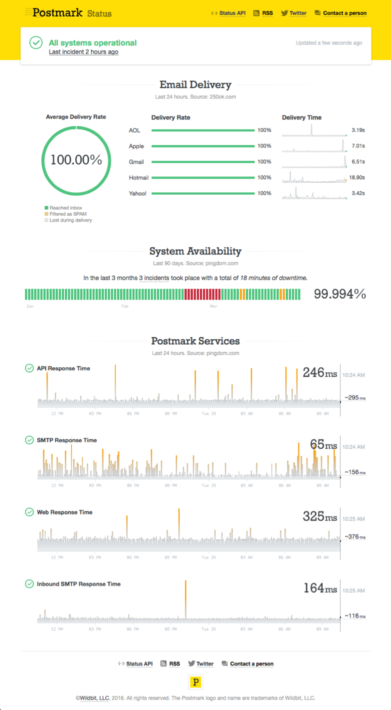Why delivery speed matters
If you talk to someone about email deliverability these days, you’ll probably end up talking about inbox rates. What percentage are going to the inbox? What percentage to spam? What percentage is missing? These are all good and important, but they aren’t enough. How quickly they arrive is just as important. Which begs the question, why don’t we hear more about it? We have some theories, but regardless of the reasons, we think that needs to change.

Sending transactional email looks easy on the surface. Choose an email service provider (ESP), connect, and send emails. However, there’s much more to it than what’s on the surface. Due to spam, phishing, and other email scams, Internet Service Providers (ISPs - like Gmail and Yahoo) are more cautious than ever. If you’re not careful, there’s no assurance your emails will arrive in the inbox at all, let alone quickly.
We feel strongly that fast delivery to the inbox is a core service for every email service provider, not an add-on or up charge.
How slow transactional emails cost you money #
To appreciate the value of getting emails to the inbox quickly, let’s take a step back and discuss why speed is so critical for transactional emails by looking at examples where missing or delayed emails directly affect your bottom-line.
Forgot password. Lost sale. #
Let’s say you run an e-commerce business. Imagine a customer who ordered from you some time back and setup an account. The customer returned, and they’ve added a few items to their cart. They’re ready to checkout, but when they go to login, they’ve forgotten their password. Fortunately, your site is a paragon of usability and your visitor easily requests a password reset. Then they go to their inbox and wait. And wait. But after more than a minute, a different important email arrives in their inbox, they get distracted, and they move on to handle that email. If all goes well, they’ll eventually receive the password reset email, and maybe they’ll finish the purchase. But if they don’t, you’ve lost a sale.
Where’s my license key? I’ll just ask support. #
Another all-too-common example happens when software companies send license keys via email. A visitor successfully purchases some software and immediately goes to their inbox to get the license key and start using their newly purchased software. And then they wait. And wait. Of course, you already have their money, so you may not think this is a problem. But then when that license email doesn’t show up, they email your support team to inquire about the status of their order. Multiply this process by 10's or 100’s of support requests, and you’ll quickly see how delayed emails can lead to unnecessary support costs. At high enough volume, this can mean having to hire more people. One customer switched to Postmark for precisely this reason and saw their support requests from lost or delayed receipt emails disappear almost entirely.
Death by 1,000 cuts #
Unless you operate on a large scale, the costs of the delays may not be obvious. But stories like these happen every day because too many applications take email for granted. You may assume that hitting “Send” is good enough, and that it will get there when it gets there. But your choice of ESP can have a significant impact ensuring that the emails arrive promptly. Service providers just need to be more forthcoming about the true quality of their delivery.
The dirty little secret of email service providers #
There’s a dirty little secret among email service providers. ESPs get paid for sending emails, not delivering them. So, while most ESPs do care about delivery, they don’t have the financial incentive to do an amazing job of delivery. Their incentives lie primarily with quantity not quality. So long as quality is good enough, they still get paid. As a result, there’s little incentive to focus on speed or transparency. And as a customer, the impacts on your bottom line may not be immediately obvious.
As customers, we’ve come to accept this. While inbox rates are beginning to be a regular part of the discussion, it’s secondary and doesn’t address delivery times. Since ISPs behave as a black box in order to protect their spam-fighting tactics, ESPs frequently claim that delivery is ultimately out of their control. As a result, they focus on generating revenue by pushing volume or selling dedicated IP addresses.
Some providers even charge extra for “improved deliverability.” This enables their pricing to appear more competitive on the surface, but firmly illustrates the difference between sending email and delivering it. We feel strongly that fast delivery to the inbox is a core service for every email service provider, not an add-on or up charge.
Most ESPs boast about the volume of email sent but never say a word about their inbox rates or delivery speed. Remember, spammers could brag about sending billions of emails too.
Bulk marketing email vs. Transactional email #
The focus on volume leads most email service providers to support sending bulk email. There’s a lot of money in it. Unfortunately, sending bulk marketing emails and transactional emails from the same place means that your important and high value transactional emails can end up in line behind larger bulk marketing campaigns. So at times, your transactional emails could be delayed significantly unless you’re segregating your bulk and transactional email streams.
ISPs are also great at distinguishing bulk email versus transactional emails. When they see email from one source going to thousands of users all at the same time, they know that it’s bulk, and they may throttle it for inspection or filtering. They also factor engagement into reputation, and since transactional emails have significantly higher engagement, this benefits the reputation of servers and domains that are only sending transactional email. Over time, ISPs build a history of which IP addresses and domains are used to send bulk, and they begin to give email from those servers lower priority. In short, if your bulk and transactional are coming from the same place, your transactional emails will suffer.
If bulk marketing emails create so many problems, why don’t ESPs do something about it? The answer is simple. With low prices, they have to move a lot of quantity to make money. So most ESPs desperately need the revenue from bulk campaigns regardless of the overall impact to deliverability. Most ESPs boast about the volume of email sent but never say a word about their inbox rates or delivery speed. Remember, spammers could brag about sending billions of emails too.
At Postmark, we focus exclusively on transactional email and don’t allow bulk marketing email. This specialization means our costs are a little higher, but it also means that we don’t suffer from any of the drawbacks of bulk marketing email. We maintain a better reputation with ISPs, and our inbox rates and delivery speeds are some of the best in the industry. They’re so good that we’re not afraid to share them and will be publicizing all of the details on our new status page.
It’s time for increased transparency #

Each and every ISP maintains their own rules and handles throttling and delays differently. So for ESPs to stay on top of things, they have to constantly monitor delivery speeds and inbox rates for each of the major providers like Gmail, Yahoo, Hotmail, Outlook, AOL, and iCloud. However, while most ESPs have some of this information, they don’t share it because it doesn’t always paint a flattering picture.
We think it’s time for ESPs to step up and become more transparent about their success and failure rates. We’ve been taking small steps in this direction for some time by exposing the fine-grained detail of delivery events for each message. That helps you troubleshoot individual messages, but it doesn’t help you know how Postmark is doing overall on deliverability. We always wanted to share more insight, but it takes time to do this right.
Next week, we’ll launch a brand new status page and status API to help address this. You’ll be able to see our delivery rates for all of the major ISPs (Gmail, Yahoo, Outlook, AOL, and iCloud). Right next to that information, you’ll also be able to see our average delivery speed for each of the major ISPs as well. We’ll also be sharing the methodology, tools, and details behind our calculations so that it’s crystal clear how everything works.
It’s long overdue for email service providers like Postmark to become more transparent with their performance. We understand that it’s not easy, but we believe that when you select an email provider, you’re not just paying for a dumb pipe or a service that merely sends emails. You’re looking for a service that delivers them.


